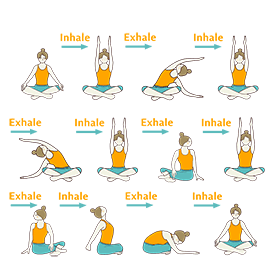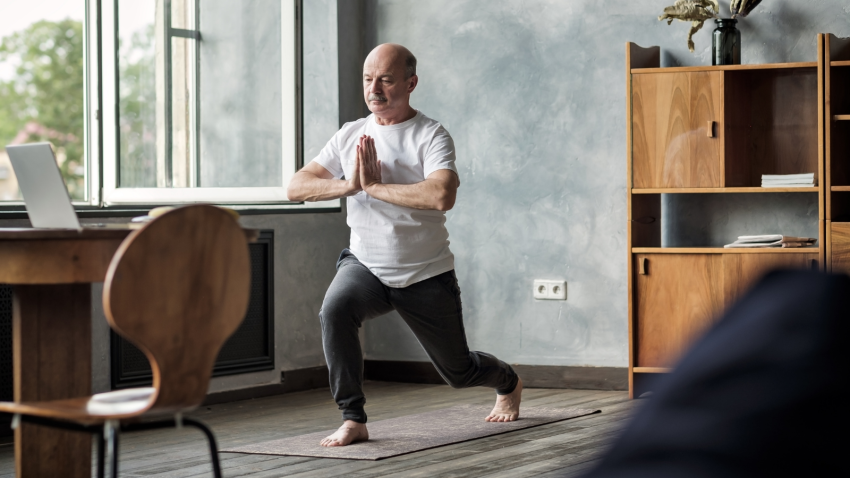
The restorative poses in yoga have many benefits, including improved circulation, strengthening of the bones and muscles, and improved nerve function. It can also help relieve stress and increase feelings of well-being. These poses are ideal for people with achy backs, necks, and shoulders. The following are some examples of the different restorative poses. You might want to give them a try, or consult a yoga instructor.
The first is the savasana. The first position involves folding the body in half and placing the feet and hands on the floor. The back should be straight, the chest should reach your knees and the head should meet the spine. To relax, you need to be able to sink into your senses. As the fascia begins to release, the muscles begin relaxing. After three or four breaths, the physical component of the pose begins to dissipate and the body settles into a state of calm.
To do the shoulder relaxation pose, draw your shoulder blades together. The palms are facing up, and the torso is held in place with soft elbows. The blankets can be used to support the head and elevate the torso. After mastering the pose, you can increase the length. As an additional support option, pillows or blocks can be used. For beginners, it is recommended to practice for five- to ten minutes.

Another restorative pose involves the use of props to create the perfect environment for the body to fully relax and open. A bolster can be placed under your pelvis to support you. To make certain poses more comfortable or more effective, you may need to use blankets or pillows. Restorative poses allow your body to relax and help you meditate. This type of yoga is perfect for people who are suffering from chronic pain or back injuries. This type of yoga is great for people who have joint problems.
Yoga's restorative postures may be the best way for you to relax and get better sleep. If you're not a fan of standing and moving, you can use props to hold the pose for as long as you can tolerate. You might find the poses more difficult to hold due to the extra weight of the props. For beginners, you might try restorative Yoga to help slow down and relax.
Yoga poses that promote relaxation are called restorative yoga. You will feel relaxed and supported while performing the poses. They aren't just great for sleeping. You can get the benefits of restorative Yoga anytime you want by using props. These poses can easily be performed at any hour, day or night. They also promote relaxation. The bolster can be used in many positions, including sitting.
You don't need props to do restorative yoga poses. This style of yoga aims to restore your body. Restorative postures are meant to balance the nervous system and calm the mind. Relaxing by focusing on the breath can help you relax, focus on what is important to you, and allow your mind and body to connect. There are many benefits to practicing restorative yoga.

Apart from using props in restorative, you should also be aware of the many benefits of restorative postures. They can help improve your mood after a difficult day at work. They can be done in a studio. Although these poses can be a great way to relax and let go of stress, they are not meant to be used for meditation. They are designed to help you heal and promote your overall well-being.
To add warmth and weight to your mat, you will also need bolsters or blankets. Mexican blankets are a popular choice for yoga studios. You can use cork or wood blocks for restorative yoga. Boosters, which are large pillows with stiffness, can be used to support your back. You can have them in any shape you like, including rectangular or round. You should stretch your joints and muscles when you do these poses.
FAQ
What is the best exercise routine to build muscle?
Two main types of exercises are required for building muscle mass. These are called compound movements and isolation. Isolation exercises target particular muscles, while compound movements focus more on several groups at once.
It is important to do exercises that work all of your major muscles groups. This ensures that each session is challenging.
To keep track of what you have done, use an app called MyFitnessPal. It allows you log everything, including calories burned and weight lifted. You can also make custom meal plans according to your goals.
What is butter good for?
Butter is one of the best sources of saturated fats. This type fat is great for your skin and hair. It also helps you build stronger bones.
Vitamin K is also found in butter, which helps prevent bleeding from cuts or bruises. Vitamin K and vitamin C work together to prevent bruising.
Butter is also rich in minerals, including calcium, phosphorous, and potassium. These elements help to build stronger bones and teeth.
Butter has its drawbacks. Butter contains high levels of cholesterol. There are studies that show excess cholesterol may increase the likelihood of developing cardiovascular diseases.
Butter is also high in saturated fat which can lead to obesity and higher cholesterol.
But if butter is a must, you can spread it on bread and not dip it in soups or salads. Bread absorbs less oil than pasta and potatoes.
Cardio Exercise: Good or Bad for Your Health?
Cardiovascular exercise has many benefits. It improves blood circulation, strengthens heart muscle, gives you energy, and can even help you lose weight.
Cardiovascular exercise includes running, biking, hiking, swimming, tennis, basketball, soccer, volleyball, football, etc.
Cardio exercises should be avoided at high intensity levels. Doing this could lead to injury.
The cardiovascular exercise should only be performed if you feel good.
You should never push yourself beyond your limits. You could injure yourself if you do.
Begin by warming up before engaging in cardio exercise. Then, gradually build up to higher intensity levels.
Listen to your body. You should stop immediately if you feel any pain while doing cardiovascular exercise.
After a cardiovascular training session, it is recommended that you take some time to relax. This will allow your muscles to rest.
To lose weight, you should include cardiovascular exercise in your daily routine.
This is the best way to lose weight and belly fat.
Statistics
- According to the American Heart Association, blood pressure should be checked at least once every two years, beginning at age 20. (my.clevelandclinic.org)
- Cardmembers earn 5% Back at Amazon.com with a Prime Credit Card. (amazon.com)
- Candidates and applicants must pass all four tests at 70% (minimum level) to graduate from Basic Deputy U.S. Marshal (BDUSM) Training. (usmarshals.gov)
- Are You One of the 20% of Guys (mh.co.za)
- 10 pounds in a month is likely during a lean bulking phase, especially for beginners. (muscleandstrength.com)
External Links
How To
What nutrients does a person need every day?
Men require daily nutrition for healthy growth and development. The body requires vitamins and minerals, protein, carbohydrates, fats (fats), water, fiber, as well other essential elements.
The male body also requires specific nutrients at different times throughout the day. Your body makes hormones, antibodies and enzymes when you are asleep. When you wake up, your body uses protein to repair damaged tissue and build muscles.
Your body stores extra energy as glycogen and breaks down fat at night. Your body requires fewer calories, but still needs enough nutrients. If you feel hungry, you may consider having a snack during the evening.
You need to eat enough carbs and protein when you exercise. After a hard workout, muscle soreness may occur.
To avoid this, you need to eat carbs and proteins within two hours of training. To get energy from glucose, your body will start to degrade stored glycogen.
Also, protein must be consumed immediately after your workouts. This prevents muscle tissue from being broken down while you are sleeping.
Your body makes lactic acid when you are doing intense physical activities. It builds up in your bloodstream, which can lead to fatigue. Avoid this by eating foods rich in carbohydrates such as fruits or vegetables.
Carbohydrates provide energy for your body to recover after strenuous exercise.
Additionally, lean meats, fish and eggs, dairy products, yogurt, cream, cheese, yogurt and beans can be added to your diet.
All of these foods contain high-quality protein. Protein is important for muscle growth and repair. It also provides the amino acids your body needs to produce sex hormones and testosterone.
Good skin, hair, and joint health requires adequate dietary fats. Healthy men should consume between 20% to 35% of their daily caloric intake from fat.
Fat is good for your heart and helps you fight cancer. It is essential for proper brain function.
Vegetable oils such as sunflower oil and soybean oil can provide most of your fat needs.
These oils contain high levels of monounsaturated fat acids (MUFAs). MUFAs lower cholesterol and decrease inflammation. They protect cells against damage from free radicals.
Saturated fats (SFAs), are found mainly in animal products such as meat, milk products, and butter. SFAs are known to raise LDL ("bad") cholesterol and raise triglycerides. They promote weight gain as well as belly fat.
Polyunsaturated fats (PUFAs) are found in plant-based sources like vegetable oils, nuts, seeds, and grains. PUFAs are good for your heart health and help to reduce inflammation. They can also control blood sugar levels and cholesterol.
Low HDL ("good") cholesterol is a common cause of erectile dysfunction in men. A high intake of saturated fats leads to higher levels of bad cholesterol.
Men who eat lots of red meat or pork can develop prostate problems. This is because these foods contain high amounts of nitrates. High temperatures can cause nitrates to become nitrosamines. These compounds can lead to cancer.
Nitrites and other harmful chemicals are common in processed meats. Avoid them.
The American Heart Association recommends eating no more than 2 servings of red meat per week. Instead, choose poultry or fish, beans, tofu and whole grain bread.